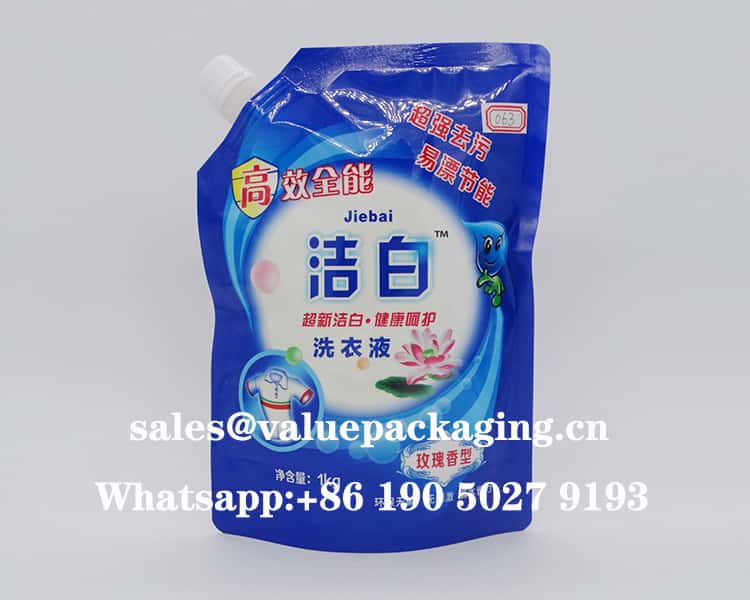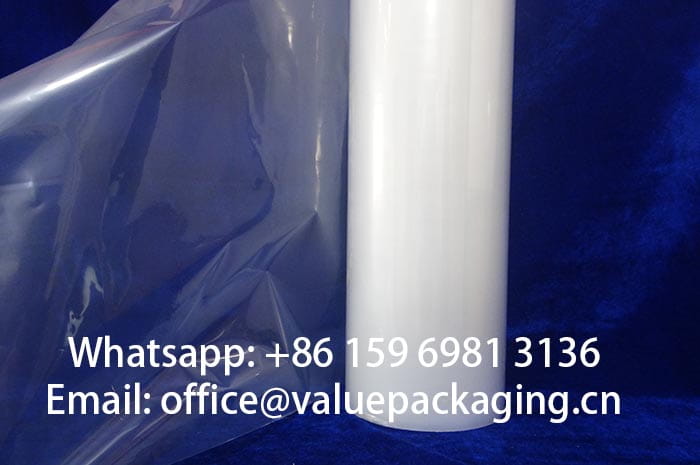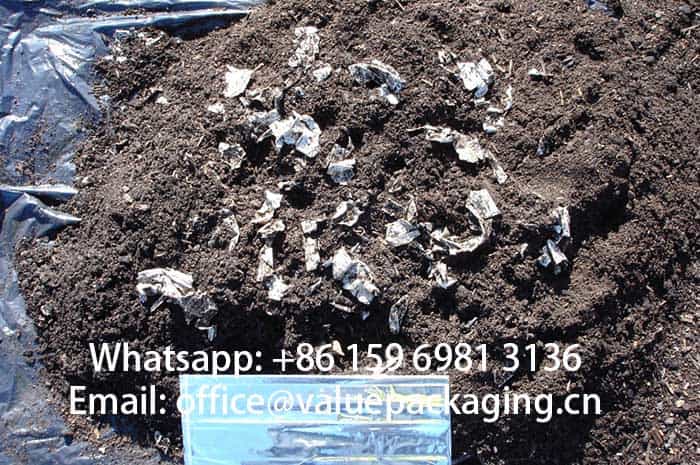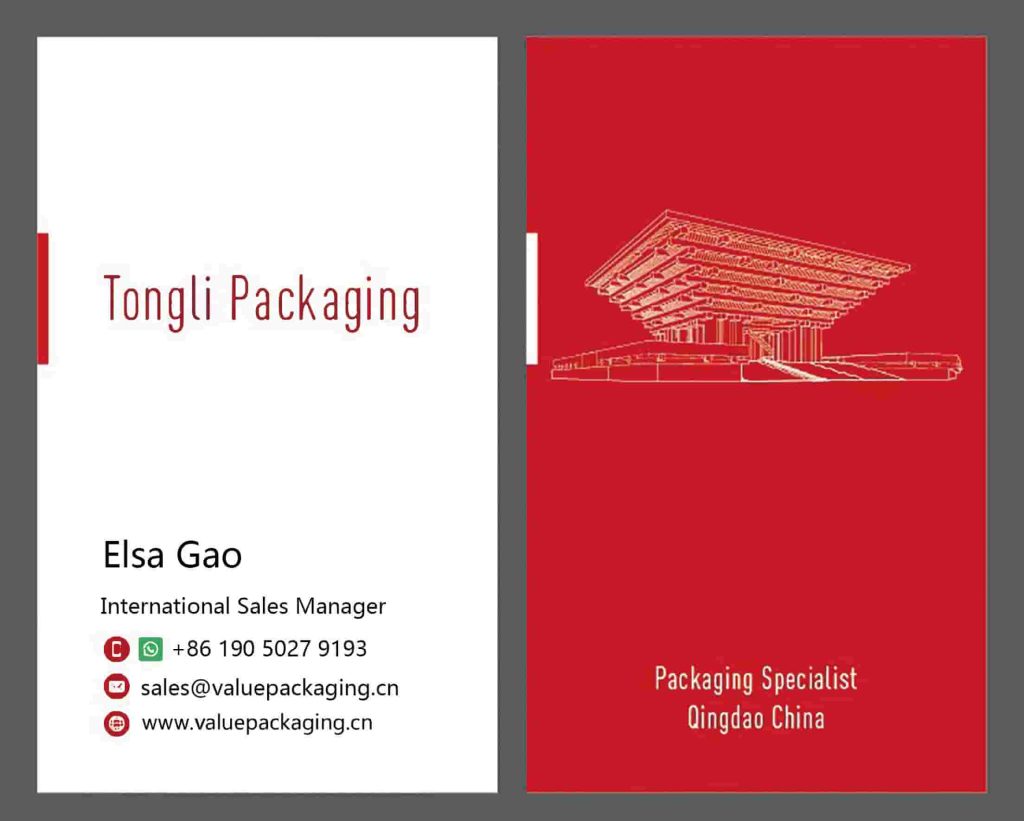
Stand-up spout pouches have become one of the most widely used packaging formats for household liquid laundry detergents. Their bottom gusset structure not only increases the pouch’s capacity but also allows the package to stand firmly on shelves, creating a cleaner and more appealing presentation at retail.
To ensure reliable performance during filling, transportation, and distribution, the laminate materials used for these pouches must be strong, durable, and highly resistant to stress. By combining different polymer films, the laminate structure provides excellent barrier protection against oxygen, moisture, and light – effectively preserving the quality and stability of the detergent inside.
In addition, creative artwork can be printed across all sides of the pouch, offering ample space for branding, product information, and visual appeal. This 360-degree printable surface helps enhance shelf presence and strengthens consumer engagement, making the final package both functional and visually compelling.
As a well-known flexible converter located in Qingdao, China, we are making the best use of the packaging film materials in the market, which are listed below.
- fossil chemical polymer films
- Aluminum foil metal sheet
- Vacuum metalized film materials
- Ceramic film substrates
- plant-based biopolymer materials
- Biodegradable film materials
- Compostable substrate films
- Fully recyclable substrate films
We are devoted to creating story-telling standup screw cap bags for household laundry detergent that increase product sales and establish a good brand image.
In this post, we will analyze the exact foil materials of this 1liter laundry detergent standup bag, hoping it could serve as a reference for your products.

Packaging Foil Materials
The figure below shows the composition structure of this laminated foil material used to convert this stand-up laundry detergent bag.

It is made of triplex layers, with the outside PET film 12 microns working as the print substrate film, the PA film 15 microns working as the middle supportive layer, and finally, the LDPE film working as the inner sealing layer. The thickness of the LDPE film should be adjusted to suit the requirements of 1 Liter detergent liquids.
Next, let’s get into a deeper understanding of each substrate film material.
PET Film

PET film is one of the most widely used printing substrates in flexible packaging. It offers excellent optical clarity, high gloss, strong chemical resistance, and stable mechanical strength. Its exceptional dimensional stability and outstanding printability ensure that customer artwork is reproduced vividly and accurately. These properties not only enhance shelf appeal but also provide reliable structural support to the final package.
In the flexible packaging industry, the most commonly used thickness for PET film is 12 microns, which is equivalent to 0.48 gauge. Therefore, whenever you see references to PET12 or 0.48 g PET, you can understand that they refer to the same material
PA Film

BOPA stands for Biaxially Oriented Polyamide film, also known as biaxially oriented nylon (NY) film.
BOPA film is known for its exceptional tensile strength, excellent puncture resistance, and high barrier properties, making it a reliable material for applications requiring strong protection against impact and mechanical stress. Its durability and performance stability allow it to withstand demanding packaging environments while maintaining product integrity.
LDPE Film

LDPE (Low-Density Polyethylene) is one of the most widely used inner sealing layers for stand-up juice pouches. It is lightweight, easy to process, and provides excellent chemical resistance and impact strength. As a recyclable and reusable material, LDPE is also considered a more sustainable alternative to traditional plastics. It is nontoxic, non-contaminating, and offers high durability against breakage.
One of the key advantages of LDPE is its versatility. The film can be customized to meet the specific sealing, strength, and protection requirements of different products. The thickness of the LDPE layer is adjusted based on the intended application to ensure optimal performance.
For products such as liquid detergents, LDPE formulations may require additional modification to resist alkaline corrosion. Since each detergent formula is different, the polyethylene blend must be tailored accordingly to maintain barrier integrity and sealing strength.
These 3 layers are bonded together into a finished laminated foil material under the dry lamination or solvent-free lamination process. Usually, we describe the finished laminate as PET12/PA15/LDPE foil.
Great Standup Effect
Through the video below, you may learn the standing effect when 3 liters of liquid detergent are filled into a spout bag based on this laminated foil PET12/PA15/LDPE.
Mechanical Property
The spout pouch is engineered to protect liquid laundry detergent throughout filling, transportation, and distribution. Its durable structure is designed to withstand unexpected impacts – such as delivery shocks or accidental drops from shelves-preventing breakage and eliminating the risk of leakage that could contaminate floors, cartons, or storage areas.
At our manufacturing facility, the mechanical integrity of every 1 Liter stand-up laundry detergent sachet is our highest priority. Our quality control system applies strict inspection and testing standards to ensure every batch meets the required performance criteria.
One of the most reliable ways to verify a package’s impact resistance is through a drop test conducted on filled pouches. This simple yet effective test allows us to confirm that the packaging can endure sudden shocks without bursting, ensuring safe handling throughout the supply chain.
Here, we are going to fill 1800ml of water into this bag, perform the drop test from 1.6 meters high, 3 times, and check if it breaks.
This foil laminate can be good for detergent liquid packs of 1 liter, 2 liters, 3 liters, and even 1 gallon. Of course, there are reinforced foil structures available for more robust packages.
- PET12/PA25/LDPE
- PA15/PA15/LDPE
- PA15/PA25/LDPE
Barrier Performance
Generally, the essential formulas of a household laundry detergent liquid should include, but not be limited to, the list below.
- primary and secondary surfactants
- chelating agents
- enzymes
- builders
- bleaching agents
- optical brighteners
- Foam control agents
- fragrances
- colorants
- preservatives
Based on industry experience, all bags and sachets for liquid laundry detergents should be fully light-shielding to protect the formula and ensure optimal performance. Exposure to strong light can weaken the cleaning effectiveness, and certain fragrances may degrade or deteriorate over time.
To maintain product stability and fragrance quality, laundry detergent packaging must effectively block light, helping the formula stay active and high performing for as long as possible.
Furthermore, WVTR (short for water vapor transmission rate) and OTR (Oxygen Transmission Rate) are evaluated for this laminated foil to decide if this spout doy-pack is finally meeting the requirements of each customer.
| Item | Standard | Unit | Typical Value |
| Water Vapor Transimission Rate | ASTM E 96 | g/m2/24hr | 19.5 |
| Oxygen Transmission Rate | ASTM D 372-99 | cc/m2/24hr | 8.5 |
Technical Data Sheet of 1 Liter laundry detergent liquid pouch
Here, we attach the specification sheet of this 1 Liter laundry detergent liquid sachet based on foil laminate PET12/PA15/LDPE180.
More tests are included in this specification sheet, with items available listed below.
- Yield (grams per square meter)
- Tensile Strength (MPa)
- Elongation Rate (%)
- Coefficient of friction, short as COF
- Solvents Left (mg/m2 )
- Sealing Strength (N/15mm)
- Sealing Conditions
- Bond Strength (N/15mm)
- Burst Strength (J)
- Anti-puncture ability (N)
- Drop Test Ability (cm)
- Anti-pressure ability (kgs)
- Water Vapor Transmission Rate (g/m2/24hr)
- Oxygen Transmission Rate (cc/m2/24hr)
If you want to further understand this PET/PA/LDPE laminated foil, you may just read it here.
More Sustainable Materials Options
With the growing environmental burden caused by discarded fossil-based polymer materials, the demand for sustainable packaging has never been greater. This shift is driving businesses toward more eco-friendly practices. Recent studies in the detergent market show that consumers are increasingly inclined to purchase products that demonstrate a clear commitment to environmental sustainability.
Compostable Packaging Materials

The compostable packages are based on plant-based fibers like cellulose, or bio-mass like corn starch, cassava, or sugarcane. The resins derived from these resources are usually named biopolymer, which can break down into inorganic elements under the functions of algae, bacteria, and other microorganisms.

Fully Recyclable Mono Materials
Compared with the high cost of compostable foil materials, fully recyclable mono-material sachets and roll stocks have rapidly become popular in the market due to their much lower price and excellent adaptability for lightweight packaging.
Mono-material packaging means that every layer of the multilayer film is made from the same base resin, allowing the material to be easily processed through existing recycling systems and reused for other applications. This significantly reduces the amount of plastic film waste ending up in landfills.
Today, we have successfully developed spout pouches made entirely from single-resin films, which have shown excellent performance for chili sauce and other viscous food products. Due to the current limitations in mechanical strength of recyclable materials, the recommended maximum capacity for these mono-material pouches is 250 ml or below to ensure optimal stability and durability.
Ok, let’s end here, you may reach us if you have any questions, nice day.

